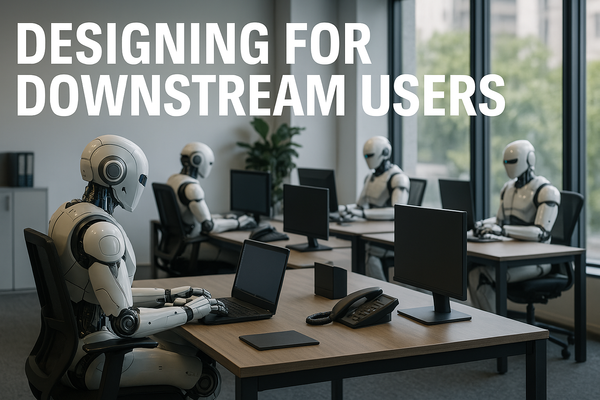Google's Willow: The Quantum Leap into the Future of Technology

We’re witnessing a pivotal moment in the world of computing. It’s not every day that a single breakthrough can redefine our perception of what’s possible. Yet that’s precisely what Google’s Willow chip represents—a quantum leap that promises to reshape how we solve problems, build products, and expand human potential.
For product teams—designers, engineers, architects, and managers—this milestone prompts two urgent questions: What does quantum mean for our work? And how do we prepare for or guide this transformation before it disrupts every industry on Earth?
The short answer: Pay close attention now. Quantum computing, once a distant concept, is edging closer to commercial viability. When paired with AI, it could radically alter product roadmaps, workflows, and entire business models. Let’s begin with what Willow signals about our quantum future, then explore why merging quantum and AI could spark mind-blowing transformations—and how product leaders can stay ahead.
Google’s Willow Chip: The Quantum Milestone That Changes Everything
What Happened?
Google announced that its quantum processor, Willow, solved a problem in five minutes that would take classical computers roughly 10 septillion years—an incomprehensibly vast span dwarfing the age of the universe. Even more remarkable, Willow addressed one of quantum’s biggest challenges: error amplification. Traditionally, adding more qubits (quantum bits) increases noise (instability), but Willow showed that scaling can actually reduce errors—a breakthrough hinting at bigger, more robust quantum machines.
Why It Matters
- Rewriting “Impossible” Problems: Quantum computers excel at tasks considered intractable for classical machines—like factoring enormous cryptographic keys or simulating complex molecules for drug discovery. Willow brings “impossible” closer to “someday soon.”
- Path to Practical Quantum: By tackling noise at larger scales, Willow is the first real sign that error-corrected quantum machines could leave the lab and enter real-world applications faster than we thought.
Still, a roadmap lies ahead:
- Long-Lived Logical Qubits – to reliably hold information
- Developing Logical Gates – for consistent operations
- Scaling to Thousands (or Millions) of Qubits – without overwhelming noise
- Error-Corrected Quantum Computers – stable enough for real-world use
Though the finish line isn’t just around the corner, product teams should start laying the groundwork for quantum’s eventual arrival.
Why Quantum + AI = A Whole New World
Quantum computing alone is transformative but pairing it with AI unleashes potential that once lived in science fiction. Willow’s success accelerates this synergy, opening some major frontiers, let's look at three examples.
Curing All Diseases
Drug discovery is notoriously slow and expensive, often spanning a decade and billions of dollars to deliver a single treatment. Quantum computers can, in theory, simulate molecular interactions at detail levels classical machines can’t match; AI can then analyze those results, accelerating compound identification and optimization. This could slash R&D timelines from years to months.
For product leaders in healthcare this could mean:
- Rapid Prototyping: Iterate on drug designs and treatment models swiftly.
- Personalized Medicine: Combine quantum simulations with AI-driven predictions for tailored therapies.
- Preventative Care: Quantum-powered AI systems could highlight high-risk populations and recommend lifestyle changes before diseases develop.
Realizing Superintelligent General AI
Classical computing places natural limits on AI’s growth. Quantum hardware knocks down those walls, enabling AI to explore countless parallel possibilities. This jump in processing power brings us closer to artificial general intelligence (AGI), where machines could learn and adapt with unprecedented flexibility.
Implications for product teams today:
- Richer Product Roadmaps: Tools move from “smart automation” to “creative problem-solving.”
- Human-AI Collaboration: Designers must address ethics, user trust, and interpretability as AI grows more autonomous.
- Data Overhaul: Infrastructure will need to handle quantum encryption and new data architectures.
Terraforming Planets
This might sound sci-fi, but quantum could simulate planetary ecosystems in breathtaking detail, while AI orchestrates the engineering logistics. Imagine planning terraforming strategies for Mars or other celestial bodies.
Entire new domains could open up, such as:
- Accurate Climate Modeling: Even Earth stands to benefit from more accurate environmental forecasts.
- Terraforming and Space Exploration: Quantum-AI collaborations pave the way for off-world habitats and new commercial opportunities.
The Economics of Quantum and AI: Thrive or Fall Behind
Adopting advanced technology isn’t just about chasing the cutting edge—it’s about survival. For product leaders, cost-benefit analysis becomes the crux: Does quantum or AI adoption yield outcomes traditional methods can’t?
Cost Calculus
- Operational Costs: Quantum hardware is expensive but likely to follow a downward price curve (similar to GPUs).
- Productivity Gains: Complex simulations or data tasks could drop from months to minutes, transforming industries like pharma, logistics, or manufacturing.
- Risk vs. Reward: Being an early adopter carries risk, but waiting could lead to obsolescence as competitors leverage quantum’s advantages.
Real-Life ROI: A biotech investing in quantum-driven drug discovery could trim multi-year R&D cycles down to weeks, unveiling new cures and saving billions. The societal and competitive edge would be immense.
Strategies for Product Leaders: Building for a Quantum-AI Future
Seeing the potential is one thing—acting on it is another. Whether you’re in healthcare, consumer tech, or SaaS, preparing for quantum + AI requires new mindsets and plans.
- Focus on Outcomes, Not Features
Always ask: “Does this solve a user or business problem more effectively?” - Design for Ethical and Transparent Use
Growing AI power raises issues of bias, privacy, and accountability. Embed ethical guardrails early. - Reimagine Product Roadmaps
Assess where quantum or AI could deliver tangible benefits and consider pilot projects to build internal expertise. - Invest in Specialized Talent
Recruit or train quantum-aware developers and researchers; consider partnerships with universities or startups. - Cultivate Cross-Functional Collaboration
Align product, engineering, data science, and design to find practical quantum-AI use cases. - Stay Agile
Quantum and AI evolve rapidly. Maintain flexible product cycles and be ready to pivot as breakthroughs emerge.
Building Trust: The Cornerstone of Adoption
Quantum-powered AI will shape vital decisions, from medical treatments to environmental policy. Success hinges on public trust—ensuring these technologies are reliable, transparent, and fair is a job for today and can't wait until the technologies are commonplace.
- Transparency: Explain how AI decisions are made and what data is being used.
- Ethical Considerations: Who benefits first from quantum-driven breakthroughs, and how do we maintain equity?
- Regulation and Policy: Governments are still grappling with AI rules; quantum adds another dimension. Early engagement with regulators can prevent future roadblocks.
Conclusion: Seizing This Moment
Google’s Willow chip offers a glimpse of a quantum-powered future where once-impossible tasks happen in minutes and AI’s capabilities skyrocket. But the story isn’t complete without product leaders who are ready to align strategy, ethics, and execution.
Three Takeaways to Act On
- Immerse Yourself in Quantum Now: Get familiar with the basics so you can pivot as the tech matures.
- Be Ready to Prototype and Experiment: Small pilots or proofs-of-concept reveal where quantum and AI can deliver real value, as the technology evolves be ready to act quickly.
- Champion Trust and Transparency: Reliability and fairness will determine how widely—and how quickly—these technologies take hold so build the frameworks today.
When quantum and AI converge, possibilities multiply: curing diseases, achieving general AI, even terraforming distant worlds. That might sound fantastical, but it’s closer than we think. The future belongs to those who see beyond today’s limits—and start building now.
Let’s seize the moment.



